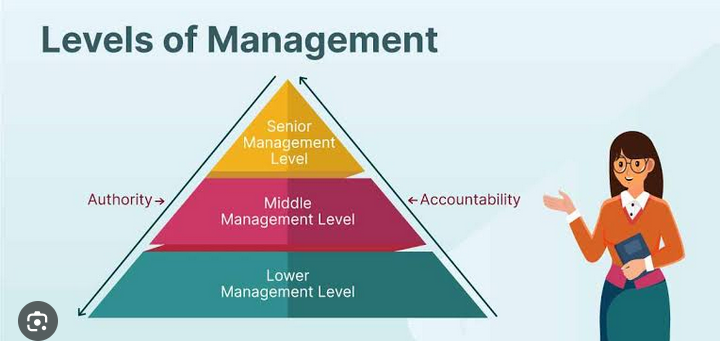Archival management
2. Level of management
Level of Management
Level of management refers to a line of demarcation between various managerial positions in an organization.
Three main levels of management are:
Top level
Middle level management
Lower level management
Figure1: Management level structure
Top Level management/ Strategic level/ Administrative level management
Upper level of management in an organization that usually includes board of directors, managing director, deputy director, managing directors officers and deputy chief executive officers.
Role of Top level management
Lays down the objectives and role principles of the organization.
Issues necessary introductions for preparation of departmental budget procedure and
schedules.
It prepares strategic plans and policies for the enterprise.
It appoints executive for middle level e.g. departmental managers.
It controls and co-ordinates the activity of all the departments.
It is responsible for maintain the contact with the outside world.
Providing guidance and direction.
Responsible towards shareholders for the performance enterprise.
Middle level of management
In management of many companies middle level makes the largest group and usually includes the branch manager, chief librarian, marketing manager, human resource manager and departmental managers.
Role of middle level of management
They execute the plans of operation in accordance with the policies and directives of the top management.
Makes plans for deserve units of the organization
Participates in employment and training of lower level management
Interprets and explain policies form the top level to lower level management.
Responsible for coordinating activities within their divisions (department)
Send important report to the top level management.
Evaluate performance of junior mangers
Responsible for inspiring lower level management towards their better achievements.
Lower level management/ opposition/ first line management
This management level comprises of people who supervise workers of a company and usually include supervisors, departmental heads and foremen.
Roles of lower level management
Assigning jobs and tasks to various workers
Guide and interact workers for day to day activities
Responsible for quality as well as quantity of production
Motivates workers
They are the image builders of the enterprise
Ensure discipline in the enterprise
They are arranging necessary materials, machines tools for getting things done.
Supervise and guide the subordinate
Help in solving the grievances of the workers
10. Communicate workers problems, suggestion and recommendatory appeals to the higher
level.
Managerial work involves activities and therefore consists of actions. They listen, talk, write, meet, observe and participate. Managerial activities consist of three major processes namely:
Information gathering
Mangers collect information from several sources within outside the organization.
Information analysis
Mangers continually analyze the information using different methods.
Decision making
After analyzing the information they make decision and take actions.
The most common areas of management are:
Marketing management.
Operational management.
Financial management.
Staffing human resource management
Marketing management involves marketing managers who are responsible for pricing, promoting the product and distributing the services and products of the organization. They conduct market research plan and oversee the distribution network.
Operation management involves operation mangers who are responsible for the actual creation of the goods and services for the organization. Their responsibilities include: production, inventory and plant layout.
Financial management involves finance mangers responsible for managing the financial resources of the organization (financial allocators)
Human resource management involves managers responsible for managing the human resource of the organization.

